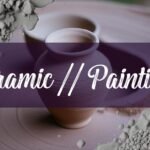Overglaze enamels are like the *final flourish* on a beautiful piece of pottery, adding layers of color and detail that can transform a simple form into a **_stunning work of art_**. These enamels are essentially decorative materials that you apply to a ceramic piece after it’s already been glazed and fired. Then, you fire it again at a lower temperature to fuse the enamel to the glaze. Think of it as adding the final strokes of paint to a canvas, bringing the whole piece to life!
The magic of overglaze enamels lies in their chemical composition. They typically start with frits, which are pre-melted glassy substances made of silica (SiO₂) and fluxes. These fluxes help lower the melting point, making everything fuse nicely in the kiln. For instance, one patent lists a frit containing around 45-50% SiO₂, 9-12% Al₂O₃, and other components like B₂O₃, Na₂O, and ZnO. Then come the opacifiers, like tin oxide (SnO₂) or zirconium oxide (ZrO₂), which make the enamels opaque, giving them that solid, vibrant look.
And of course, we can’t forget the colorants! Metallic oxides like iron oxide (Fe₂O₃) for reds and browns, cobalt oxide (Co₃O₄) for blues, and chromium oxide (Cr₂O₃) for greens are used to create a rainbow of possibilities. Fluxes like lead oxide (Pb₃O₄) (though less common now due to toxicity) and boron compounds help everything melt smoothly, while stabilizers like antimony oxide (Sb₂O₃) and zinc oxide (ZnO) enhance the enamel’s durability and gloss. Some recipes even include bone ash or lithium oxide (Li₂O) to tweak the texture and thermal expansion. You can also read about unlocking glaze chemistry for more information.
Firing temperatures are ***crucial*** when working with overglaze enamels. Generally, lead-based enamels fire at around 750°C to 950°C (1,382°F to 1,742°F), while lead-free enamels often need slightly higher temperatures, like 1,450°F (787°C) to 1,600°F (871°C). For a complete guide, refer to firing temperatures for potters.
It’s a delicate balance, as you want the enamel to fuse without softening the underlying glaze too much.
You can apply overglaze enamels in several ways, each offering a different effect. Painting with brushes allows for intricate, hand-painted designs, though it can be tricky to get even coverage. Spraying, on the other hand, is great for covering large areas smoothly, but it requires a bit of practice to avoid over-spraying. Silk screening is perfect for repeating precise patterns, but it involves creating custom screens and a bit more setup. Each method has its pros and cons, so the best choice depends on the design and the desired effect.
Of course, working with overglaze enamels isn’t always smooth sailing. You might encounter issues like blistering, pinholing, or unexpected color changes. Blistering, those annoying bubbles on the surface, can happen if the firing temperature is too high or if there are gases trapped in the glaze. Pinholing, those tiny holes in the glaze, can be caused by organic materials in the clay or a glaze that’s too viscous.
And sometimes, the colors might shift due to the firing atmosphere or interactions between the pigments and the underlying glaze. The key to preventing these problems is to control the firing conditions, adjust the glaze formulation, and always do test firings to see how the enamels and glazes will react together. Other common issues include crazing, which are those fine cracks caused by mismatched thermal expansion rates, and crawling, where the glaze pulls away from the surface due to contamination or high surface tension. But don’t let these potential pitfalls discourage you! With a bit of knowledge and careful attention to detail, you can create ***stunning pieces*** with overglaze enamels.
With a bit of knowledge and careful attention to detail, you can create stunning pieces with overglaze enamels.
Overglaze enamels have a rich history, dating back to ancient Egypt around 1500 BC, where artisans used them to add vibrant colors to their ceramics. The technique was further refined in China, particularly during the Kangxi reign (1662–1722), leading to the development of the “famille rose” palette with its beautiful pink hues. In Japan, Sakaida Kakiemon I perfected the overglaze enamel technique in Arita, creating the renowned Kakiemon ware with its delicate colors. Europe embraced overglaze enamels in the 17th century, with Dutch potters in Delft emulating Asian styles.
Overglaze printing emerged in England around 1750, allowing for more intricate designs. Today, there’s a resurgence of interest in overglaze enamels, with artists around the world reinventing this technique and creating stunning, colorful works. So, whether you’re drawn to the historical techniques or eager to experiment with modern approaches, overglaze enamels offer ***endless possibilities*** for adding beauty and depth to your pottery.





